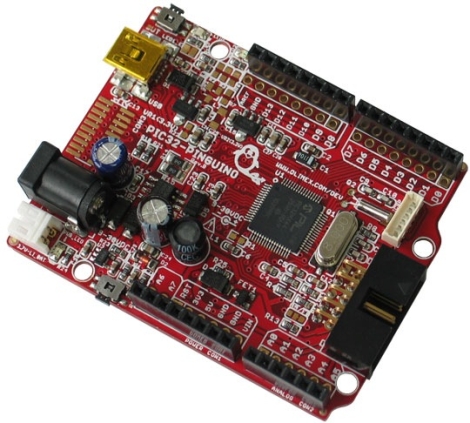
[Phillip Torrone] from Make recently sat down with [Jean-Pierre Mandon] and [Tsvetan Usunov], creators of the Pinguino, to hear more about their product. While the name might not sound familiar, we’re pretty sure you’ll be seeing more of this development platform as time goes on.
Essentially created by makers for makers, the Pinguino is a 32-bit PIC based Arduino-compatible prototyping platform, much like Microchip’s chipKIT. The Pinguino boasts 100% Arduino compatibility just as the chipKIT, though their tool chain has been built from scratch, meaning it is completely open source. The Pinguino even include an on-board microSD slot and a built-in Li-Po charger – two huge features that make this a solid chipKit competitor.
Phil discusses the history of the Pinguino with the pair, diving into technical differences between the two platforms, as well as where they plan on taking the platform in the future. It’s certainly an interesting read for anyone interested in open software and hardware that has been considering giving the chipKIT a try.















While the name might not sound familiar
No, it’s sounds very familiar.
Pinguinos are also delicious Little Debbie/Hohos style snack cakes.
I like that we’re moving to 32-bit processors. I think they are going to enable a whole new class of maker-built gadgets.
Its awesome that we now will have a completely unrestricted compiler chain for PIC32.
Shouldn’t be too hard to get the ChipKITs supported either. Anyone know if there are plans?
That’s quite a densely populated PCB! Anyone know what the secondary crystal oscillator is for?
If the price is reasonable, this could be an interesting dev board to work with… The completely open toolchain is also quite appealing.
It looks like real time clock crystal.
So it’s not really PIC-based is it then? It uses a PIC32, which is itself built around the MIPS architecture. Rather big difference! An 8-bit accumulator machine with a rather strange attitude towards registers and RAM that’s used to control waching machines vs. a 32-bit advanced RISC machine (in some aspects the primary competitor to the Advanced RISC Machine even) that’s been used at the heart of the PS1, PS2, PSP, and N64, not to mention the many SGI workstations.
A PIC-based Arduino clone would be close to worthless, this PIC32 one on the other hand might prove to be very competitive.
I believe they are planning on offering one of those original pic boards too, from the looks of their website
One Kool-Aid drinker calling another actual inventor a Kool-Aid adict, hmmm
Competition in this space is a wonderful thing for all of us. It provides choices and in the end it will put pressure on the Arduino providers to make their stuff even better. It will put pressure on the shield makers not to be so Arduino specific.
This would be good news for all of us hobbyist even if it wasn’t introducing anything new. The fact that there are some neat new features makes it even better no matter what flavor of Kool-Aid you may have drank a little too much of….
@tim its a two way street, any AVR post is greeted with “I would have done it with pic blah blah blah” and every pic post is greeted with the fact that AVR is superior in every way.
Surely you don’t know the whole PIC microcontroller family
Do you wanna more non-arduino projects?
pyroelectro.com
I would have used a mini itx with linux so I can emulate an arduino. J/k lol
Looks like a very well thought out board, although Ethernet could have been a very cheap plus.
Great news about the tool chain, this is something microchip should have addressed themselves years ago.
I’m not sure where the whole 32 bit embedded market is going but from the hacker / maker market the Raspberry Pi is going to be difficult to take on. Ok it doesn’t have shield compatibility but what it doesn’t have onboard can be added via USB a lot cheaper.
I’m watching Raspberry Pi (foot tapping anxiously).
ADB support, nice :)